
Thinking About The Future
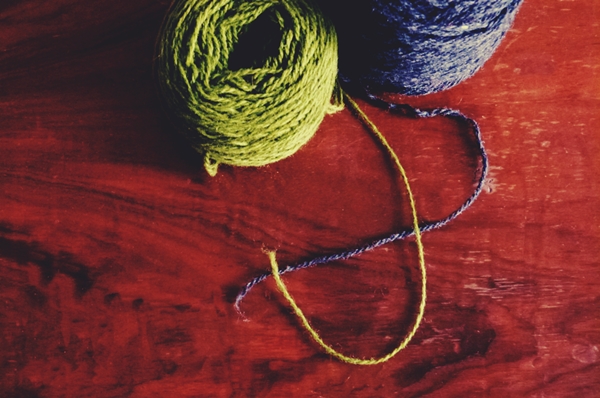 For the past eight years or so, we've enjoyed a surge in quality indie designers offering amazing patterns for us to download. A digital revolution has changed crafting completely: knitters (and crocheters) came out as the winners because we suddenly had all these fantastic designers at our disposal with just one click of a button. From Ysolda Teague & Stephen West to Kate Davies & Gudrun Johnston, many designers started with a single pattern and gradually started growing as designers and businesses. I don't know if you know, but the knitting & crochet community is going through a bit of a sea-change at the minute. Making that same journey is going to be awfully hard in years to come and the real losers are the knitters and crocheters.
For the past eight years or so, we've enjoyed a surge in quality indie designers offering amazing patterns for us to download. A digital revolution has changed crafting completely: knitters (and crocheters) came out as the winners because we suddenly had all these fantastic designers at our disposal with just one click of a button. From Ysolda Teague & Stephen West to Kate Davies & Gudrun Johnston, many designers started with a single pattern and gradually started growing as designers and businesses. I don't know if you know, but the knitting & crochet community is going through a bit of a sea-change at the minute. Making that same journey is going to be awfully hard in years to come and the real losers are the knitters and crocheters.
It's a dull and technical thing, really. The EU is changing laws about digital sales (in an attempt to stop Big Business from dodging taxes) but the UK is implementing the laws in a way that's very damaging to small sole traders (if you want to learn more, Woolly Wormhead has written extensively about it).
Digital downloads have changed the knitting industry forever but incoming legislation will complicate things immensely. The knitting community I love and treasure so much will now become an bit of a gated community for many aspiring designers. It worries me and saddens me because I am a firm believer in diversity and innovation.
On a tangentially related note, I found this essay by an American indie rock band interesting. They talk about the realities of going on tour and how they are "making it" rather than "having made it". Sometimes it really hits you hard when you realise how much daily grinding is involved in creatives trying to make a reality of their dreams and talents.
Me? I wrote an article for Wovember about the relationship between sheep, wool and designer. Because that is where I am at and that is what I do.
ETA: I write this from a UK perspective because that is where I live. However, these law changes affect anyone who sells digitally online to EU customers - even designers living in Australia, the US or Easter Island.
Important Announcements
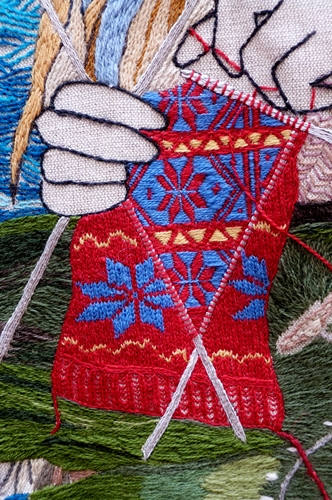 Folks, there are going to be some changes around here.
My work/life balance has been seriously dysfunctional for some time and I am feeling the toll. In order to avoid burning out and crashing out of my job, I'm simply going to make some changes to how I offer support. I am very sorry. I love hearing from you guys - I really, really do and I hope you know this - but I also need time to design and write stuff.
Folks, there are going to be some changes around here.
My work/life balance has been seriously dysfunctional for some time and I am feeling the toll. In order to avoid burning out and crashing out of my job, I'm simply going to make some changes to how I offer support. I am very sorry. I love hearing from you guys - I really, really do and I hope you know this - but I also need time to design and write stuff.
These are the main changes:
1. I am going to have set office hours: Tuesdays and Thursdays between 10am and 4pm, I will be at my desk dealing with emails, pattern queries, media requests and all the other stuff.
2. I will no longer be dealing with pattern queries via my Ravelry inbox. Likewise, I won't be able to help with queries on Twitter or Facebook. Please use my email for pattern queries (the email address is on the Ravelry receipt).
3. I am going to encourage you to use my Ravelry group as much as possible because a) the people there are amazing, b) many of them have knitted everything I've designed several times, and c) it's likely that your query has been answered there before. Really, go join the group. It's great!
4. I am working on a FAQ which I hope to have finished in the next few weeks.
5. I cannot offer general knitting help - I only offer help with my own patterns, I am afraid. For general knitting problems, knittinghelp.com is a fantastic and undervalued resource. Likewise, if you have any technical issues with my patterns, try checking the Ravelry Help pages.
Hopefully these changes will mean a less stressed-out Karie which means a happier Karie which means more Karie-stuff from Karie! (And I'll use pronouns more responsibly too.)
Another change is afoot:
I have been dragging my feet over this, but I have to adjust my pricing come January 1st. I haven't adjusted my prices in years despite rising costs, but I can no longer afford to keep prices where they are now. This means that my £3 patterns will go up to £3.75 - I am trying to keep the ebook collections at the same price as they are now, but I will have to review this decision again come summer. I really do not like passing on costs to customers and I am very sorry about having to do this.
Thank you so, so much for your understanding.
Knitting Journeys
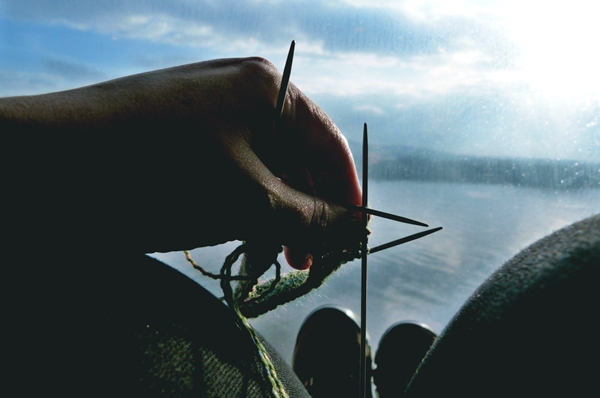 I love travelling on ferries. I suppose I could blame my Viking blood, but I have always found sailing immensely enjoyable and relaxing. Last week I visited Northern Ireland for the first time which meant a long ferry ride across the Irish Sea as well as a long bus journey through the Scottish Lowlands. The journey home was especially lovely as the sun was out and I found myself a window seat where I could knit away and watch the waves without getting disturbed. Utter bliss.
I love travelling on ferries. I suppose I could blame my Viking blood, but I have always found sailing immensely enjoyable and relaxing. Last week I visited Northern Ireland for the first time which meant a long ferry ride across the Irish Sea as well as a long bus journey through the Scottish Lowlands. The journey home was especially lovely as the sun was out and I found myself a window seat where I could knit away and watch the waves without getting disturbed. Utter bliss.
I'll write more about this towards the end of the year, but I have realised that knitting is both a journey for me as well as something that makes me travel to all corners of the British Isles.
At the heart of it, every knitting project is a journey. You begin travelling as soon as you cast on and the process of your project is the road you are travelling. The language of geography is intertwined with the language of knitting: the yarn travels through our fingers, we have travelling stitches and we consult charts to help us navigate a challenging pattern. Then, as we near the end of our project, we have the diary of our trip in our lap. Do you remember the day that you worked the rib section? How happy you were to cross that river or climb that mountain? Or the evening you sat knitting dreaming of future adventures as you traversed across an endless desert of stocking stitch?
And it also means something else for me personally.
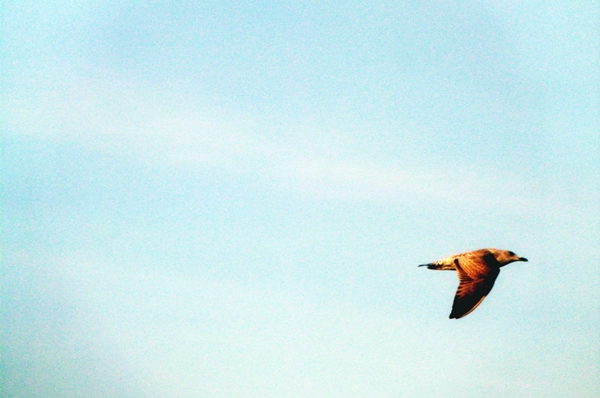
Currently I am knitting socks. They are the perfect travel project and they kept me entertained during my stay in Northern Ireland (no internet connection! it was lovely!). I have designed three sock patterns for the Old Maiden Aunt Sock Club 2015 (also three exclusive never-to-be-repeated OMA colourways) and I really, really enjoyed the experience. A sock is a very different canvas to, say, a shawl and I relished playing with this new-to-me canvas.
I am currently on my second almost-vanilla sock. This pair is just for me and my journeys around these isles. Who knows what will happen next.
Shouting Loudly About Wool - An Interview with Louise Scollay
 As I mentioned the other day, I named my first cardigan design after one of the most inspirational people I know in the knitting world: Louise Scollay.
As I mentioned the other day, I named my first cardigan design after one of the most inspirational people I know in the knitting world: Louise Scollay.
Louise lives in Shetland where she writes and blogs fuelled by her passion for wool - and especially good quality, local British yarns. She champions small local producers, encourages big companies to support the British wool industry and she is especially keen on making knitters aware that knitting British (or local) does not mean you have to spend a fortune. We have some incredible local yarns in Britain and we should be shouting to the heavens about them.
Needless to say, Louise and I get on very well! We share that passion for honest, authentic yarns that have a strong grounding in a particular landscape. Some people think I am mad for loving "rustic" yarns so much, but Louise understands. This shared understanding led to a good friendship and now .. an interview.

What makes you so passionate about championing wool - and particularly local, British wool?
When I started KnitBritish I just wanted to shout loudly about the wool I was using and really hoped that someone might find it interesting, learn something along with me and try British wool for themselves. Until a few years ago it never occurred to me to look at where the wool came from. I was just drawn to texture and colours. When I realised that there were over 60 breeds of sheep breeds in the UK - not to forget alpaca, angora, mohair and cashmere - I just knew that I had to try them all (spoiler: I haven’t managed yet).
What I am passionate about now is trying to move us away from the idea that British wool is not suitable for next to skin wear, or it is not suitable for hand-knitting. There are plenty of UK sheep whose fleece is more suited to carpets and upholstery, but we have an amazing resource of wool - varied in handle, texture, colour, and characteristics - which are not enjoying their place in the country’s stash next to the merino that many knitters are drawn towards. British breed wool is astonishing! Each is unique and different, e.g. Bluefaced Leicester and Wensleydale are both longwool breeds, but they do not provide the same kind of fleece. I urge more people to just jump over to Blacker, select a ball of yarn that they have never tried before and just give it a go.

Blacker Yarns, ah yes. Their selection is amazing. I got a sampler back recently and it's mind-blowing just how different the various breeds knit up. I can see why it's an absorbing project to try out all the various breeds. Along the same lines, I have to ask: What are some of your favourite British yarns?

This is true. when I began getting into local yarns, there were very few available from commercial companies. However, in the last couple of years, even the commercial selection has become huge. You mentioned going into J&S - you obviously live in Shetland. Do you think the complex knitting heritage of Shetland plays a part in your desire to champion local producers?
Knitting here has had its big peaks and bigger troughs. When I think of Shetland’s knitting heritage I think about subsistence knitting, the exploitation and poor wages of many knitters. I think of Shetland knitting being the forefront of fashion trends through the beginning of the 20th century and declining again, until the oil industry into the 80s helped boost the industry and economy. Knitting has never gone away here - granted much of the industry knitting in the past was done with little pleasure for the craft - but you can’t really chuck a ball of wool here without hitting someone who can knit. Knitting was even a part of the curriculum in Shetland schools for many years (until recently). I feel very rooted to that heritage, coming from knitting and crofting stock, and maybe that is why I feel strongly about supporting our home-grown wool resources. KnitBritish started because I bought a yarn that came from a farm just a short trip from my back door, so it definitely started here.

Where can people learn more about local British yarns?
If anyone is interested in finding British breed wool there are three main havens for me; Blacker Yarns are a fantastic resource for British, organic, rare and specialist breeds. They source all fleece - and fibre for their alpaca and mohair yarns - from Britain and also from the Falkland Islands while all of the processing and spinning takes place in the UK. There is plenty of information on the characteristics of the wool, handle and information on the breed. Blacker is truly an invaluable resource and they are really committed to providing the best of British available. Garthernor is another excellent resource, particularly if you are looking for organic yarn. The website can be a little clunky to navigate, but it is jam-packed with information on sheep breeds and there is a shop. They do blends of British breeds as well, which adds new textural and colour interest. I always recommend that anyone interested in knitting with rare breed yarn, or in British sheep breeds in general, should look at the Rare Breeds Survival Trust website. There is a watch list of the critical, endangered, vulnerable and at risk breeds - if you are interested in doing some small part in helping these breeds, knitting with their wool is a good place to start.

Finally, how has Knit British changed your knitting life?
…I think the most awesome thing is that I have been able meet such amazing people through what I do. I truly love the communities I find myself in through wool and knitting - particularly through social media. I count myself very lucky that someone I hadn’t met till this year (though I already called my friend) decided to name a cardigan pattern after me. That’s pretty awesome.
Well, you are pretty awesome, Louise.
Louise is part of the Wovember team and will also be cheerleading at the podcast lounge of the Edinburgh Yarn Festival. Go say hi to her!
Say Hello to the Scollay Cardigan
 2014 turns out to be the year where I break free from all the ..but surely I can't .. whispers at the back of my head. I am fully self-employed, I have been part of all sorts of incredible craft events with properly big knitting names, and now I've released my first garment pattern. Designing garments always felt daunting because they have to fit across sizes, there are all sorts of things to keep track off, and (crucially) they have to fit people other than me.
So, say hello to Scollay.
2014 turns out to be the year where I break free from all the ..but surely I can't .. whispers at the back of my head. I am fully self-employed, I have been part of all sorts of incredible craft events with properly big knitting names, and now I've released my first garment pattern. Designing garments always felt daunting because they have to fit across sizes, there are all sorts of things to keep track off, and (crucially) they have to fit people other than me.
So, say hello to Scollay.
Scollay is published in the latest Knit Now magazine (issue 41, in shops this week). I have a long-standing working relationship with the editor, so I knew I could trust the editorial team to be on-board with my first garment and lend me moral support. And I really think we got it right.
The inspiration behind the cardigan is two-fold.
Firstly, I knew I wanted an everyday cardigan which would work as a layering piece. I am mildly obsessed with "the everyday wardrobe" where you have some some amazing essential pieces you go back to again and again. I wanted to design a cardigan I knew I could just put on - I think we all have those garments that only work with a certain shirt and I wanted to avoid that.
Secondly, I was hugely inspired by the work of Louise Scollay who runs the Knit British website and podcast. Louise champions the idea of using local yarns and is very vocal about how supporting local yarns is both affordable and sustainable. I knew I wanted to use a local yarn for my cardigan - and then the name of the pattern became obvious: Scollay. I have an interview with her coming up on this blog where I'll be asking her just how it feels to have a pattern named after you!
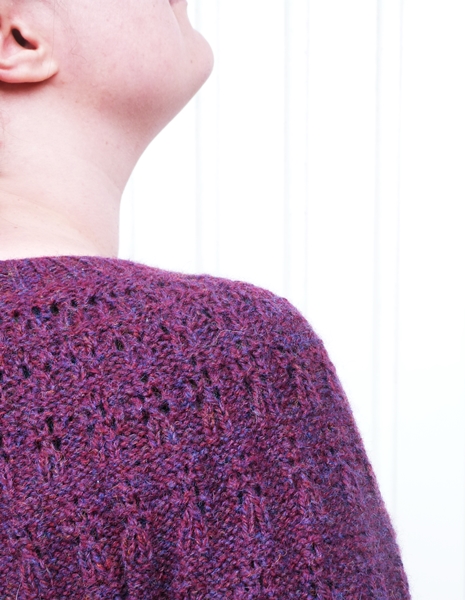
The Scollay cardigan is knitted in New Lanark DK which is spun just down the road from me. New Lanark is a UNESCO Heritage site which spins its own yarn using the Falls of Clyde to power its mill. It is not a coincidence that I chose to work with this yarn - I have visited New Lanark many times and the site holds special significance to me. Scollay's seamless construction cuts down on the amount of yarn you need and New Lanark is astonishing affordable at just £3.50 per ball. £3.50 for a piece of British industrial heritage, Scottish progressive social history and a yarn imbued with landscape, history, meaning, locality, and soul?
Oh come on.
A few suggestions for modifications. The cardigan is knitted bottom-up with the sleeves and body joined before you work the yoke. This sort of construction allows for relatively easy mods:
- the cardigan hits me well below the hips (as you can tell) but I am really short-waisted. If you want a slightly shorter cardigan, take out an inch before and after the waist shaping.
- you can adjust the length of the sleeves by taking out a couple of inches before you join the sleeves to the body.
- it is designed to have a smidgen of positive ease because I wanted a cardigan that would work for layering. The model in the magazine looks super-cool in her relaxed fit cardi. However, I am wearing the cardigan with an inch of negative ease.
- I do love the New Lanark yarn with a fiery passion, but it has a lot of character which I understand is not for all people (though it works perfectly for me). If you are looking for a substitute, you need to look for a double-knitting yarn with good stitch definition and memory. The construction means the yoke bears the weight of the garment, so make sure you find a substitute with sturdiness - cottons and silk-blends won't work in the long run.
It is such a thrill to finally be able to blog about the cardigan. I designed it in the spring and knitted it during the hottest Scottish summer in memory (I am modelling it on a hot July day in these photos ) - so it's been a hard secret to keep. But it is released this week and I finally feel like I am a proper grown-up designer. Heh.
